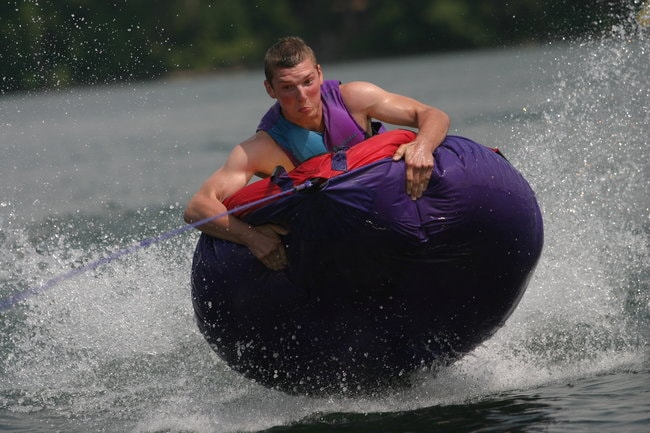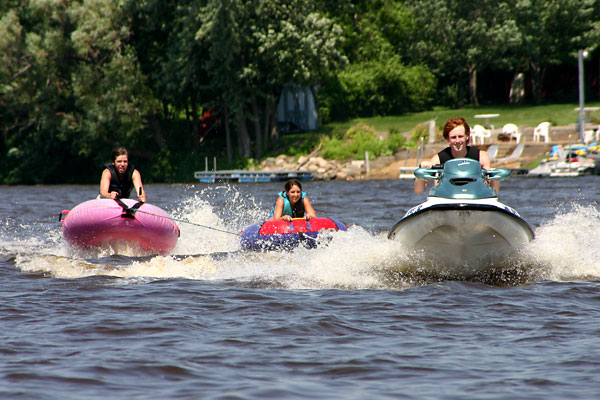Going tubing with your friends and family this summer and need some tips for pulling a tube behind your boat? If so, you are in the right place.
Tubing is undoubtedly an exciting watersport if you know how to do it properly.
However, there are specific rules you must follow to have a fun ride on the water while staying safe. So, I have prepared a guide where you’ll find all you need to know about how to pull a tube behind a boat. Read on!
Before You Get On The Water
Before you start tubing, you need to get ready so that you don’t have to come back onshore or, hopefully not, have an unpleasant surprise. First, I’ll give you a small reminder about safety precautions, and then I’ll talk about what you need.
1. Life Jackets: As we all know, safety comes first, so before you get on the water, you and the riders must wear a US Coast Guard Approved life jacket. Make sure it’s comfortable and fits correctly.
2. Attachment point: Decide where you’ll be attaching your towable to your boat. If you secure your towable to a ski pylon or tow bar, ensure the height doesn’t exceed 70cm (2ft); otherwise, it can be dangerous.
Avoid using cleats to pull your towable, as they are not designed for towing tubes. A transom eye is your best bet to pull a towable.
However, it’s always a good idea to speak with the boat manufacturer before and see if the transom eye can withstand the towing force specified on the tube’s label.
3. Prepare your gear: If you secure the tow rope to a low attachment point, it will get underwater and will cause the water to splash straight on the rider’s face, which is not pleasant. So to have a fun ride, there are a few things you would want to get, such as:
- You can use a booster ball or a turbo swing to keep the tow rope out of the water.
- Another gear you should consider is a Y harness bridle. This helps distribute the load between the transom eyes and keep the tow line more centered, providing a much safer and enjoyable riding experience.
- Finally, get a quick connect to secure the rope to the towable for maximum safety.
4. Inflate the towable: To have a good time on the water, it’s super important to inflate your towable properly. It must be firm to the touch and free of wrinkles.
If the towable is under-inflated, this will cause the tube to sit lower in the water. And as a result will put more pressure on the tube, rope, and even your boat since it will drag the tube through the water instead of pulling it.
To inflate your towable easily, use a high-quality electric pump or 12-volt pump complimented with a hand pump. That will do the job.
Getting On The Water
1. Towable types: Towable tubes come in lay-down or sit-down styles, and each can provide a different riding experience on the water.
For instance, flat tubes give a much slicker ride but can get bouncy, which some people will love, of course. Also, since they have a flat surface, getting them to take off is easier, but they can whip pretty hard, making them great for teenagers or adults seeking adrenaline rushes.
It goes without saying that putting small children on a flat tube wouldn’t be a good idea unless they are used to it.
Sit-down tubes provide more protection on the sides and a more comfortable ride on the water. The downside of those tubes is that they are harder to take off. Sit-down tubes are great for children and less athletic people.
2. Starting Out: Ok, now you have everything ready; it’s time to get on the towable and have fun. But before you turn on the engine and start, ensure your tow rope is at the right length, 50ft min, and 65ft max. If it’s too long, the tube will have difficulty taking off. Also, the riders must lean back when starting out, and once it gets on plane, they can lean forward. Finally, don’t drive too slow or fast if you want your tube to take off.
3. Speed: It’s tempting to drive fast when pulling towable because it’s fun and exciting, but controlling speed must be your top priority to stay safe. Keep in mind that if you swing a towable out, it will go double the speed of the boat. For instance, if you drive at 40mph, the tube will go at 80mph, which is very fast. 20 to 25mph is the maximum speed when pulling a tube in a straight line. In turn, you should go slower, and if you pull children, you shouldn’t exceed 8 to 12 mph, depending on the age of the children.
Do’s And Don’ts
When tubing, there are certain rules you must follow so that everyone can have fun while staying safe.
Do’s
1. Make Sure You Have All The Essential
Always have all the necessities on board to keep you and the riders comfortable and safe. Ensure you have water for everyone to stay hydrated, sunscreen, towels, and hats.
2. Be Careful When Coming Back To The Riders
When you return to the riders, be careful not to ride over your tow rope. Make sure to make a big turn and once you get to them, turn off the engine and help them get on board using the ladder.
3. Have An Eye On The Riders
Whether the law in your country requires it or not, always have a spotter on board to check if the riders are ok. They can fall off the tube, especially if you swing and send them into a wake.
4. Communicate With The Riders
One of The best ways to keep the riders safe is to talk to them before getting on the tube. Teach them some hand signals so that you can understand them from a distance. Here are some signs you want them to use when on the water:
- Thum up = faster
- Thumb down = slower
- Spinning the finger = Keep going or go around again
- Taping on the head = Stop
Don’ts
1. Never Go Tubing In High-Traffic Areas.
If the place is too crowded, you would be better off canceling the tubing sequence and postponing it to another day. Always go tubing in very open water to prevent any accidents.
2. Don’t Take Risks
Even if the tow ropes are the same length, are well secured, and you ride the boat prudently, pulling two tubes at the same time is not recommended. It can be dangerous. Yes, it’s fun, but why take such a risk?
Final Words!
That’s it! With this guide, you are all set up to have a fun a safe tubing experience. Just make sure you have all the right equipment and ensure everything is ok with your boat, of course, and enjoy!
Want More Tips?
Subscribe to Cruising Sea newsletter to receive every two-week the latest post straight to your inbox!
- Air pumps for inflatables.
- Towable tubes for boating
- How to pick the perfect towable tube
- How to repair towable tube
- How to attach a towable tube to a boat
Want More Tips?
Sign up for Cruising Sea newsletter to receive every two weeks the latest post straight to your inbox!
Do you know other great techniques to pull a tube behind a boat? If so, feel free to share your experience in the comments below.

Daniella has been passionate about travel, the sea, and nature for many years. As a child, she frequently traveled throughout the Mediterranean and continued with her journeys throughout her adult life.
Her experiences have created the desire within her to share her love for traveling with other passionate and adventurers who want to discover beautiful horizons and new cultures.




Hi Daniella,
Thanks for the article, really useful tips for a newby to boating like myself. One question, we bought our boat second hand and with it we got an old inflatable. We got it out but realised it had not been looked after and clearly had a significant amount of erosion from the sea – do you have tips for looking after and storing inflatables between use?
Thanks,
Mike
Thanks,
Hi Mike,
You are very welcome!
It depends on how bad the towable has been damaged. I have published an article about how to repair an inflatable. You can check it out. I am sure it will help you a lot!
Don’t hesitate to contact me, I am always happy to help!
Thank you for the comment and wish you a fantastic day!
Hello Daniella,
First off I love your website! I have been reading your wonderful articles for a while now and always enjoy them. I think tubing is an incredibly fun time. However, thanks to you I have learned something new. I didn’t know about the orange flag for emergencies, thank you for that. Is that a government regulation or just a common sense rule between boaters? Thank you again for another very informing article.
Hi Vic,
Thank you for the compliment, I really appreciate!
The orange flag is required when towing people behind a jet ski or boat, it’s a pre-warning signal, and yes, it is a government regulation!
I hope it helped. Let me know if you need to know further info; I’ll be more than happy to assist!
Thank you for the comment and wish you a lovely day!
Hello Daniella,
Thanks for the article, the tips are useful for me. I think tubing is wonderful time when I want to relaxed my self. But I’ve never played it before. I have one question, do you know steps on How to tow a tube behind a boat correctly step by step? – do you know how to check the the tow rope securely?
Thanks you again!
Hi Robert,
You are welcome!
Here is a video with a step by step on how to tube behind a boat like a pro:) https://youtu.be/V0nl1REcC94
And here is another video on how to check your rope: https://youtu.be/-S3Xirpt7Zs
I hope it helped. Thanks for the comment!
Thanks for your suggestions! Wish you have a good day!
You are very welcome. Have a wonderful day!
I have a pontoon boat, the ski tow says no tubes, it’s too low as well, the rope would drag on the cowling of the outboard. I was thinking about adding a couple of eyebolts and using a bridal attachment.
Hi Hal! Thanks for sharing your comment!
Have you considered using transom eyes instead of eyebolts? They’re perfect for boats like yours and won’t get in the way of the ski tow or risk scratching up your outboard. Plus, they’re tough enough to handle towing without any worries.
Give transom eyes a try! They could be just what you need for hassle-free towing on your pontoon. Let me know if you need any more tips.I’ll be more than happyu to assist.